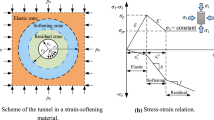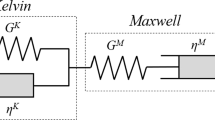Abstract
After the excavation of a tunnel, generally, rock bolts are used as primary support. Installation of rock bolts considerably reduces the further deformation in the rock mass around the tunnel boundary. Bolts provide additional support to mass and therefore mass becomes stiffer, rigid, and stronger. The theory of rock bolts–rock mass interaction is quite complex and contains numerous factors. The complex interaction between mass and bolts leads to complex theoretical analysis, and sometimes, it is very difficult to find out the solutions. Hence, to rectify this, the continuum model of numerical analysis is used which is simple and convenient. Rock mass and rock bolts are two distinct materials, and their mechanical properties are much different from each other. In continuum analysis, generally, they are modelled separately, i.e. different mechanical properties are assigned to rock mass and rock bolt. As the whole mass is treated as equivalent continua, separate modelling of the bolt and the rock mass may give misleading results. Proper interaction between mass and bolts may not develop due to the non-existence of joints in the continuum model. Hence, if, in the continuum model, rock and bolt to be modelled together with equivalent mechanical properties, the result would be different. The present research work deals with continuum analysis of a rock bolt-reinforced tunnel in which equivalent mechanical properties of bolt and rock are used. Equivalent mechanical properties were worked out from the laboratory investigations conducted on the specimens of natural jointed rock and rock bolt. The equivalent continuum model of a rock bolt-reinforced tunnel was developed, analyzed, and compared with the conventional continuum model. The result suggested that if rock bolts are taken as an integral part of the rock mass and modelled as an equivalent continua, the result would be more rational and reliable.









Similar content being viewed by others
Abbreviations
- UCS:
-
Uniaxial compressive strength
- NRC:
-
Natural rock core
- I:
-
Intact rock Intact rock
- JR_U_45°:
-
Unreinforced jointed rock with joint angle 45° from the horizontal axis
- JR_R_45°:
-
Reinforced jointed rock with 45° angle between joint and bolt
- EQM:
-
Equivalent mechanical properties
- ESR:
-
Excavation support ratio
- EBZ:
-
Equivalent bolt zone
- γ :
-
Unit weight of the material
- σ i , σ cj, σ cb :
-
Uniaxial compressive strength of intact rock, jointed rock, and reinforced rock, respectively
- E i, E j, E r :
-
Modulus of intact rock, jointed rock, and reinforced rock, respectively
- σ 1 :
-
Strength of rock at σ3 confining stress
- σ 1v and σ 1h :
-
Strength of rock in vertical and horizontal direction, respectively
- dv and dh :
-
Deformation in rock in vertical and horizontal direction, respectively
- σ 3 :
-
Applied confining stress
- c i, c j, c r :
-
Cohesion of intact rock, jointed rock, and reinforced rock, respectively
- ϕ i, ϕ j, ϕ r :
-
Friction angle of intact rock, jointed rock, and reinforced rock, respectively
- T b , E b :
-
Tensile strength and deformation modulus of rock bolt, respectively
- σ ri , E ri ,c ri, ϕ ri :
-
Reduced properties of mass used in continuum analysis (uniaxial compressive strength, modulus, cohesion, and friction angle, respectively)
- σ equ , E equ , c equ, ϕ equ :
-
Equivalent properties of mass and bolts used in continuum analysis (uniaxial compressive strength, modulus, cohesion, and friction angle, respectively)
- D v :
-
Distance starting from the crown in a vertical direction
- D h :
-
Distance starting from the crown in a horizontal direction
- B :
-
Width of tunnel
- H :
-
Height of tunnel
- H 0 :
-
Height of overburden at tunnel crown
- k sv , k sh :
-
Stiffness of rock in any vertical and horizontal direction
References
Srivastava LP, Singh M (2015) Effect of fully grouted passive bolts on joint shear strength parameters in a blocky mass. Rock Mech Rock Eng 48:1197–1206
Srivastava LP, Singh M (2015) Empirical estimation of strength of jointed rocks traversed by rock bolts based on experimental observation. Eng Geol 197:103–111
Ramamurthy T (2010) Engineering in rocks for slopes Foundations and Tunnels. PHI Learning Private Limited, New Delhi
Sitharam TG (2010) Equivalent continuum modeling of jointed rock mass. Chapter 22. In: Engineering in rocks for slopes, foundations and tunnels. PHI Learning Private Limited, New Delhi, India
Barla G, Barla M (1994) Barla continuum and discontinuum modelling in tunnel engineering. Rud Geolaqko Naftni Zbornik 12:45–57
Sakurai S (2010) Modeling strategy for jointed rock masses reinforced by rock bolts in tunneling practice. Acta Geotech 5:121–126
Sinha S, Walton G (2019) Understanding continuum and discontinuum models of rock-support interaction for excavations undergoing stress-induced spalling. Int J Rock Mech Min Sci 123:104089
Sitharam TG, Latha GM (2002) Simulation of excavations in jointed rock masses using a practical equivalent continuum approach. Int J Rock Mech Mining Sci 39(4):517–525
Singh B (1973) (1973) Continuum characterization of jointed rock masses Part I—The constitutive equations. Int J Rock Mech Sci Geomech Abstr 10:311–335
Singh B (1973) (1973) Continuum characterization of jointed rock masses Part II—Significance of low shear modulus. Int J Rock Mech Sci Geomech Abstr 10:337–349
Sitharam TG, Sridevi J, Shimizu N (2001) Practical equivalent continuum characterization of jointed rock masses. Int J Rock Mech Min Sci 38:437–448
IRC: SP: 91 (2010) Guidelines for road tunnels. Indian Road Congress, New Delhi
Singh B, Goel RK (2006)Tunneling in weak rocks. Elsevier Geo-Engineering Book Series
Hoek E (2007) Practical rock engineering. https://www.rocscience.com/assets/resources/learning/hoek/Practical-Rock-Engineering-Full-Text.pdf
Acknowledgements
The author thanks Prof. Mahendra Singh, Department of Civil Engineering, Indian Institute of Technology, Roorkee (IIT Roorkee), India, for giving valuable suggestions and support to the completion of this paper. The author also thanks to the staff of Geotechnical Engineering Laboratory, IIT Roorkee, for providing support in experimental work. The author acknowledges the contribution of Dr. R D Dwivedi, Scientists, Central Institute of Mining and Fuel Research, Roorkee Centre, India, for providing technical support in numerical analysis.
Funding
The research did not receive any specific grant from funding agencies in the public, commercial, or not-for-profit sectors.
Author information
Authors and Affiliations
Corresponding author
Ethics declarations
Conflict of Interest
The author declares that to the best of his knowledge, there are no competing interests regarding the publication of this paper.
Additional information
Publisher's Note
Springer Nature remains neutral with regard to jurisdictional claims in published maps and institutional affiliations.
Appendix
Appendix
See Figs.
a Axial stress (deviator) vs axial strain curves of intact rock (I) at different confining stresses b Axial stress vs axial strain curves of unreinforced joined rock (JR_U_45°) at different confining stresses c Axial stress vs axial strain curves of reinforced joined rock (JR_R_45°) at different confining stresses
10,
11,
12,
13,
14,
15,
Rights and permissions
About this article
Cite this article
Srivastava, L.P. Analysis of a Rock Bolt-Reinforced Tunnel with Equivalent Mechanical Properties. Indian Geotech J 52, 815–834 (2022). https://doi.org/10.1007/s40098-022-00631-1
Received:
Accepted:
Published:
Issue Date:
DOI: https://doi.org/10.1007/s40098-022-00631-1











